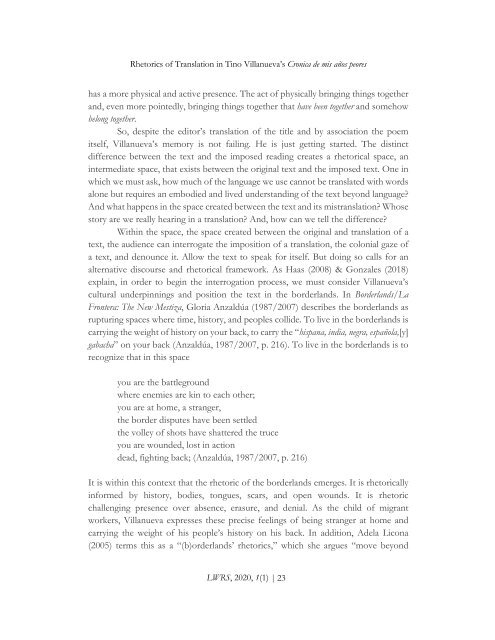LWRS June 2020 Volume 1, Issue 1
Inaugural Issue co-edited by Yndalecio Isaac Hinojosa and Isabel Baca
Inaugural Issue co-edited by Yndalecio Isaac Hinojosa and Isabel Baca
You also want an ePaper? Increase the reach of your titles
YUMPU automatically turns print PDFs into web optimized ePapers that Google loves.
Rhetorics of Translation in Tino Villanueva’s Cronica de mis años peores<br />
has a more physical and active presence. The act of physically bringing things together<br />
and, even more pointedly, bringing things together that have been together and somehow<br />
belong together.<br />
So, despite the editor’s translation of the title and by association the poem<br />
itself, Villanueva’s memory is not failing. He is just getting started. The distinct<br />
difference between the text and the imposed reading creates a rhetorical space, an<br />
intermediate space, that exists between the original text and the imposed text. One in<br />
which we must ask, how much of the language we use cannot be translated with words<br />
alone but requires an embodied and lived understanding of the text beyond language?<br />
And what happens in the space created between the text and its mistranslation? Whose<br />
story are we really hearing in a translation? And, how can we tell the difference?<br />
Within the space, the space created between the original and translation of a<br />
text, the audience can interrogate the imposition of a translation, the colonial gaze of<br />
a text, and denounce it. Allow the text to speak for itself. But doing so calls for an<br />
alternative discourse and rhetorical framework. As Haas (2008) & Gonzales (2018)<br />
explain, in order to begin the interrogation process, we must consider Villanueva’s<br />
cultural underpinnings and position the text in the borderlands. In Borderlands/La<br />
Frontera: The New Mestiza, Gloria Anzaldúa (1987/2007) describes the borderlands as<br />
rupturing spaces where time, history, and peoples collide. To live in the borderlands is<br />
carrying the weight of history on your back, to carry the “hispana, india, negra, española,[y]<br />
gabacha” on your back (Anzaldúa, 1987/2007, p. 216). To live in the borderlands is to<br />
recognize that in this space<br />
you are the battleground<br />
where enemies are kin to each other;<br />
you are at home, a stranger,<br />
the border disputes have been settled<br />
the volley of shots have shattered the truce<br />
you are wounded, lost in action<br />
dead, fighting back; (Anzaldúa, 1987/2007, p. 216)<br />
It is within this context that the rhetoric of the borderlands emerges. It is rhetorically<br />
informed by history, bodies, tongues, scars, and open wounds. It is rhetoric<br />
challenging presence over absence, erasure, and denial. As the child of migrant<br />
workers, Villanueva expresses these precise feelings of being stranger at home and<br />
carrying the weight of his people’s history on his back. In addition, Adela Licona<br />
(2005) terms this as a “(b)orderlands’ rhetorics,” which she argues “move beyond<br />
<strong>LWRS</strong>, <strong>2020</strong>, 1(1) | 23





